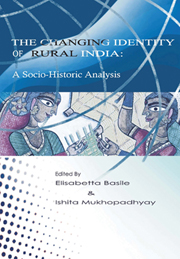Book contents
- Frontmatter
- Contents
- Acronyms and Abbreviations
- About the Authors
- INTRODUCTION
- PART 1 INDIAN RURAL TRANSFORMATIONS
- PART 2 INEQUALITY IN RURAL INDIA
- PART 3 SOCIAL MOVEMENTS AND IDENTITIES
- The Social Context of Politics in Rural West Bengal (1947–92)
- Agrarian Expansion under Colonial Rule and its Impact on a Tribal Economy
- Acting on Institutions to Preserve Agricultural Biodiversity: The Syngenta Controversy in Chhattisgarh
- The Conflicting Opinions of the Colonial Bureaucracy over the Paraiyans Right over ‘Waste’ in late 19th Century Tamil Nadu
- Appendix 1 Socio-Economic Indicators of Rural India
Agrarian Expansion under Colonial Rule and its Impact on a Tribal Economy
from PART 3 - SOCIAL MOVEMENTS AND IDENTITIES
Published online by Cambridge University Press: 05 March 2012
- Frontmatter
- Contents
- Acronyms and Abbreviations
- About the Authors
- INTRODUCTION
- PART 1 INDIAN RURAL TRANSFORMATIONS
- PART 2 INEQUALITY IN RURAL INDIA
- PART 3 SOCIAL MOVEMENTS AND IDENTITIES
- The Social Context of Politics in Rural West Bengal (1947–92)
- Agrarian Expansion under Colonial Rule and its Impact on a Tribal Economy
- Acting on Institutions to Preserve Agricultural Biodiversity: The Syngenta Controversy in Chhattisgarh
- The Conflicting Opinions of the Colonial Bureaucracy over the Paraiyans Right over ‘Waste’ in late 19th Century Tamil Nadu
- Appendix 1 Socio-Economic Indicators of Rural India
Summary
INTRODUCTION
Nationalist historians for long have interpreted the impact of colonial policies on Indian agriculture in terms of stagnation. It has been argued that British revenue policies, which functioned as a ‘built-in depressor’, effectively resulted in the flight of capital from the countryside and precluded any form of improvement in agricultural production. Challenging the nationalist paradigm in recent years revisionist historians, notably C A Bayly (1988), have argued persuasively that British rule in course of the nineteenth century had in fact resulted in the ‘consolidation of the Indian peasantry’ as pastoralist groups and shifting cultivators were increasingly forced to take to settled cultivation. It is assumed that the sedentarization of marginal groups, such as the tribal and nomadic pastoralists thus contributed significantly towards agrarian expansion. Yet, as this paper argues, expansion of settled cultivation did not necessarily negate the pauperization of the peasantry as is evidenced by developments in West Singhbhum, a remote district located in the southwestern part of Chota Nagpur Division of the erstwhile Bengal Presidency.
In Singhbhum, as in other parts of Chota Nagpur, the most significant change associated with the colonial period was the expansion of settled cultivation in the late nineteenth century. This constituted one of the ways in which the early colonial administration sought its control over the tribal people of the region. Extension of cultivation served the dual purpose of ‘civilizing’ both the countryside and the ‘savage’ through sedentarization and control of their volatility.
- Type
- Chapter
- Information
- The Changing Identity of Rural IndiaA Sociohistoric Analysis, pp. 229 - 258Publisher: Anthem PressPrint publication year: 2009

